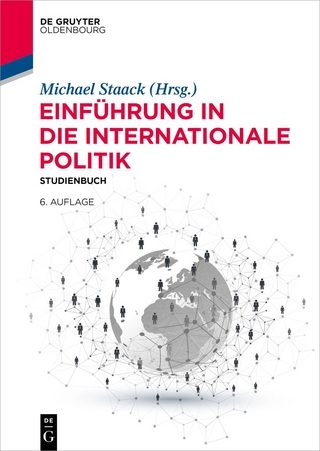
American Foreign Policy, Past, Present, Future
Pearson (Verlag)
978-0-13-193069-8 (ISBN)
- Titel erscheint in neuer Auflage
- Artikel merken
This text brings together 3 key elements for both students and professors. It provides an overview of the historical information to make sense of current U.S. foreign policy; it supplies case studies to give students grounding in key events in U.S. foreign policy and information on contemporary issues; and it incorporates concepts that structure an investigation into U.S. foreign policy. The focus is on U.S. policy itself and not on U.S. foreign policy toward specific regions or issues.
1. The Global Setting of American Foreign Policy.
Why the International System Matters.
The International System: Structural Constants.
The International System: Postwar Trends.
The International System: Emerging Characteristics of the Post Cold War World.
Plan of the Text.
2. The Emerging Foreign Policy Agenda.
Foreign Policy Problems.
The National Interest.
The Evolving Foreign Policy Agenda.
Summary and the Future.
3. The American National Style.
Isolationism versus Internationalism.
Sources of the American National Style.
Patterns.
Consequences of the American National Style.
A Revival of Wilsonianism?
Summary and the Future.
4. The Search for Grand Strategy: Post-Vietnam U.S. Foreign Policy.
The Logic and Purpose of Grand Strategy.
The Nixon (and Ford) Administrations: Leaving Vietnam and Entering Détente.
The Carter Administration: American Foreign Policy with a Purpose: Promoting Human Rights.
The Regan Administration: A Renewed Cold War.
The George H.W. Bush Administration: Leaving the Cold War and Entering A New World.
The Clinton Administration: The First Cold War Presidency.
The George W. Bush Administration: Into the War on Terrorism.
Summary and the Future.
5. Learning from the Past.
How Do Policy Makers Learn From the Past?
Events Policy Makers Learn From.
Types of Calculations Made about Those Events.
Lessons Learned.
Learning From the Past: Case Studies.
Summary.
6. The Domestic Context of American Foreign Policy.
The Media and American Foreign Policy.
Public Opinion.
Elections.
Interest Groups.
Political Protest.
Policy Maker Response.
Summary and Future Issues.
7. The Constitution and Foreign Affairs.
Treaty Making Powers.
Appointment Powers.
War Powers.
Commerce Powers.
Federalism and the States.
Summary and the Future.
8. The Presidency.
Presidential Personality.
When Does the Individual Matter?
Presidential Bureaucracy.
The National Security Council.
Other Voices.
Presidential Decision Making.
Summary and the Future.
9. Congress and Foreign Policy.
Congressional Structure and Foreign Policy.
The Influence of Party and Region.
Congress and the President: The Changing Relationship.
Summary and the Future.
10. The Foreign Affairs Bureaucracy.
The State Department.
The Defense Department.
The CIA and the Intelligence Community.
The Domestic Bureaucracies.
Summary and the Future.
11. Models of Policy Making: Overview.
The Rationale Actor Model.
Bureaucratic Politics Model.
Small Group Decision Making.
Elite Theory and Pluralism.
Summary: Integrating Models and Additional Possibilities.
12. Decision Making: Case Studies.
The Cuban Missile Crisis.
Pre 9/11 Intelligence Policy on Terrorism.
Negotiating the North American Free Trade Agreement (NAFTA).
Summary.
13. Diplomacy.
Selecting a Policy Instrument.
Bilateral Diplomacy.
Summit Diplomacy.
Conference Diplomacy.
UN Diplomacy.
Public Diplomacy.
The Political Use of Force.
Arms Transfers.
Summary and the Future.
14. Covert Action.
Techniques of Covert Action.
Congress and the CIA.
15. The Economic Instruments.
Strategic Outlooks.
Economic Sanctions.
Foreign Aid.
Summary and the Future.
16. Military Power.
Development of U.S. and Soviet Nuclear Arsenals.
What Does it All Mean?
A Historical Survey.
Post Cold War Nuclear Strategy.
Bridging the Nuclear-Conventional Divide.
Strategies for the Use of Conventional Military Force.
Summary and the Future.
17. Arms Control and Missile Defense.
Judging Success and Failure.
Superpower Arms Control.
Defense.
Counterproliferation.
The Post Cold War Agenda.
Combining Approaches.
Summary and the Future.
18. Alternative Futures.
Choices.
Alternative Futures.
The Future.
| Erscheint lt. Verlag | 14.7.2005 |
|---|---|
| Sprache | englisch |
| Gewicht | 587 g |
| Themenwelt | Sozialwissenschaften ► Politik / Verwaltung ► Europäische / Internationale Politik |
| Sozialwissenschaften ► Politik / Verwaltung ► Politische Theorie | |
| ISBN-10 | 0-13-193069-9 / 0131930699 |
| ISBN-13 | 978-0-13-193069-8 / 9780131930698 |
| Zustand | Neuware |
| Haben Sie eine Frage zum Produkt? |
aus dem Bereich


